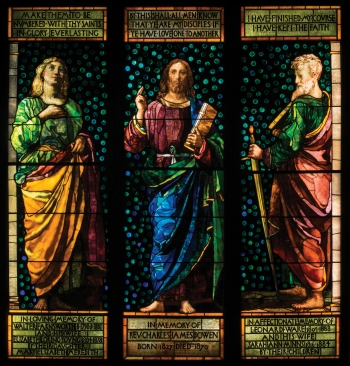
By
One of America’s most complex artists, and a pioneer in the reinvention of the art of stained glass, is the focus of the new McMullen Museum of Art exhibition, “John La Farge and the Recovery of the Sacred.”
The exclusive exhibition, which began Tuesday and runs through Dec. 13, spotlights John La Farge (1835–1910), who devised innovative solutions to negotiate boundaries between realism and symbolism. Comprising more than 85 paintings, stained glass windows and works on paper, the exhibition probes La Farge’s lifelong efforts to investigate and represent the sacred.
A special free, public event will be held this Sunday at 7 p.m. in the museum (Devlin 110) to celebrate the exhibition’s opening.
“John La Farge and the Recovery of the Sacred” demonstrates how the artist’s quest was manifest in representations of religious figures, nature, and still life as well as in stunningly imaginative book illustrations of romantic fantasy, exhibition organizers say, and also explores how La Farge’s trips to Japan and the South Seas in 1886 and 1890–91 reinforced the multicultural range of his spiritual inquiry.
Organizers say a “magnificent gift” to Boston College in 2013 from Alison and William Vareika, a 1974 Boston College alumnus, of a La Farge stained glass triptych, and the completion of its restoration, occasioned the exhibition.
“In celebrating the restoration of the spectacular gift from William and Alison Vareika of three stained glass windows by one of America’s finest artists, John La Farge, the McMullen Museum is pleased to present the first exhibition focusing, from an interdisciplinary and multicultural perspective, on the evolution of the artist’s visualization of the sacred in various media,” said McMullen Museum Director and Professor of Art History Nancy Netzer.
Born in New York City to a successful family of French émigrés and educated in Jesuit schools, La Farge began a number of religious paintings in the 1860s that were fundamental to his development, according to organizers. His goal in all projects was to recover a sense of the sacred for American culture, and central to this effort was the reinvention of the art of stained glass. His first stained glass window for Boston’s Trinity Church was installed in 1883, a depiction of Christ in Majesty that was the model for the window of Christ Preaching (1889), now at Boston College.
La Farge embodied many of the contradictions and aspirations of his age: a deep respect for tradition juxtaposed with a modernist drive to experiment with materials and to explore space and time, roaming across global cultures and past eras. He was one of the most interesting examples of the aesthetic movement of the late nineteenth century, and his art is a unique bridge between European, Asian, Islamic, and American cultures.
Professor of Art History Jeffery Howe, a scholar of 19th-century art and architecture who is the exhibition’s curator, calls La Farge “one of the most innovative artists of the late 19th century in America. The restoration of this triptych is, in a sense, a metaphor for La Farge’s revitalization of religious art.”
La Farge’s stained glass windows, Howe explained, “introduced an unsurpassed richness and subtlety of color through the use of opalescent glass and complex layering of plates of glass; he was widely credited with reinventing the medium. La Farge’s paintings, watercolors, and illustrations reveal the extraordinary breadth of his cultural and spiritual interests, ranging from European Renaissance and medieval art to Japanese art.”
Howe worked closely with William Vareika to identify relevant works by La Farge and to obtain loans for the exhibition. Captivated by La Farge’s murals and glass while meditating in Trinity Church during his sophomore year at Boston College, Vareika pursued an independent study on the artist during his senior year. He and his wife – who opened a Newport, RI, gallery in 1987 and are considered the foremost dealers in the artist’s works – have discovered and catalogued hundreds of La Farge’s pieces, 14 of which comprised earlier gifts to the McMullen. They also spearheaded campaigns to preserve, restore, and relocate his stained glass and paintings in churches in Massachusetts and Rhode Island.
The Vareikas’ recent gifts to the University include three stained glass windows representing St. John the Evangelist, Christ Preaching, and St. Paul and a promised gift of two life-size oil paintings of the Virgin and St. John the Evangelist by La Farge, also featured in the exhibition.
Originally created by La Farge in 1889, the triptych of windows was presented to the McMullen in honor of three Boston College Jesuits: University President William P. Leahy, SJ, former President and University Chancellor J. Donald Monan, SJ, and the late William Neenan, SJ; and in memory of the artist’s son, also a Jesuit, John La Farge Jr., SJ (1880–1963), beloved by many for his activism against racism and anti-Semitism. The stained glass windows will have their permanent home in the atrium of the museum’s future new location at 2101 Commonwealth Avenue, slated for completion in 2016. The two oil paintings will form part of an installation in a permanent La Farge room on the first floor of the building.
For more information on “John La Farge and the Recovery of the Sacred,” and its accompanying catalogue, see www.bc.edu/artmuseum.



